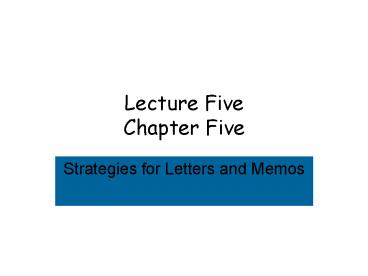Lecture Five Chapter Five - PowerPoint PPT Presentation
Title:
Lecture Five Chapter Five
Description:
Lecture Five Chapter Five Strategies for Letters and Memos – PowerPoint PPT presentation
Number of Views:40
Avg rating:3.0/5.0
Title: Lecture Five Chapter Five
1
Lecture FiveChapter Five
- Strategies for Letters and Memos
2
AUDIENCE ADAPTATION
- Develop a You Attitude
- How would I feel if I were this person in this
situation? - Increase positive impact reduce negative impact
- Anticipate questions (Who, What, When, Where,
Why, How Much) - Stress Reader Benefits
- Avoid Negatives (Claim, Allege, Problem, Damage,
Regret)
3
METACOMMUNICAITON
- STATIONERY AND TYPING
- TONE
- Friendly, Sincere
- Avoid a sense of irritation, resentment,
superiority or impatience - DICTION
- Focus on you, your, yours not I, me, mine, or we,
us, our, ours - JARGON
- ACTIVE VOICE
- EXPLETIVE CONSTRUCTION
- It, that, there is, there are
- Instead attack speaker
4
TYPES OF DIRECT AND INDIRECT LETTERS
- INDIRECT
- Negative Response to Inquiry
- Refused Claim
- Persuasive Message
- DIRECT
- Letters of Inquiry
- Favorable Response to Inquiries
- Claim Letter
- Positive Response to Claims
5
DIRECT STRATEGIES
- USE FOR GOOD NEWS OR NEUTRAL INFORMATION
- OPENING
- State main point early
- BODY
- Supporting details (reason for decision)
- ENDING
- Positive (Offer to help, statement of gratitude,
or repetition of any further action the reader
needs to take)
6
INDIRECT STRATEGIES
- Use when requests are denied, proposals rejected,
job application turned down - OPENING
- Use a buffer (neutral or positive statement,
agreement on a point, expression of appreciation,
explanation of your careful consideration - BODY
- Provide steps used in analysis of situation
- Tone is cooperative
- Express negative information clearly but
tactfully, Place in the middle of the paragraph. - ENDING
- Suggest another course of action
- Positive friendly note
- Offer services or information
7
STRATEGIES FOR HANDLING NEGATIVE MESSAGES
- PLACE NEGATIVE INFORMATION AT POINT OF LOW
EMPHASIS - We do not anticipate any openings at Baytown
Company anytime soon since we have been laying
off people in your field. You might apply at
Rumfield and Company or Bennington Inc., since
they are adding to their staff. - I suggest that you apply for one of the
engineering positions now opening at Rumfield and
Company or at Bennington, Inc., rather than at
Baytown Company. Currently Baytowns personnel
needs are in other areas. - AVOID NO OR NOT WHEN POSSIBLE
- We cannot fill your order until you tell use what
size grill your restaurant currently uses. - We can fill your order as soon as you provide us
your restaurants grill size. - AVOID WORDS WITH NEGATIVE CONNOTATIONS
- Allege, Failure, Claim, Regret, Careless, Argue,
Mistake, Damage, Error, Broken, Bone Head.
8
DIRECT - Letter Of Inquiry
- OPENING
- Make the inquiry clear from the start
- BODY
- Explanation of purpose for inquiry
- Clear organization (Not a fishing expedition for
information) - ENDING
- Friendly and build good will.
- OK to ask for a speedy reply
9
DIRECT-Favorable Response To Inquiry
- OPENING
- Identify the request (Subject line or in lst
sentence) - Make it clear the readers request is being
granted - BODY
- Respond to the request in order of importance or
as stated in original request - CLOSE
- Continue to positive tone in the close
10
DIRECT- Claim Letter
- OPENING
- Straight to the point
- Include details about faulty product or service
- Explain significance of the problem
- BODY
- Detail the facts related to the claim
- Do not attack
- State what you want done
- Set a deadline for action
- CLOSE
- Express confidence in the good faith of the reader
11
DIRECT - Positive Response To Claim
- Goal is rebuild goodwill with customer
- OPENING
- Quickly remind reader of situation then give them
the good news - BODY
- Explain what when wrong and stress how it will
not happen in the future - If product misused, explain proper use in
impersonal terms - CLOSE
- Positive with a tone of continued good relations
12
INDIRECT - Negative Response to Inquiry
- Reasons appear first followed by refusal
- OPENING
- Remind reader of claim in subject line or first
sentence - Present a BUFFER (General discussion of issues
related to inquiry) - BODY
- Discussion of why request cannot be granted.
Give reasoning then refusal. Refusal need to be
final - CLOSE
- Wish for success or provide other sources of
information
13
INDIRECT - Refused Claim
- Avoid negatives and build goodwill through
empathy(not sympathy) - OPENING
- Start with a BUFFER (referral to claim or
expression of appreciation for letter) - BODY
- Detail your findings
- Describe efforts to investigate the claim
- Once reasons given provide refusal
- If refusal based on policy explain policy
- CLOSE
- Make an effort for resale
14
INDIRECT - Persuasive Message
- Persuade people to do what they may not want to
do. - OPENING
- Catch readers attention
- Keep it brief
- BODY
- Establish a common problem and reveal solution
- Address any possible objections
- CLOSE
- Focus the readers interest into action (a
meeting, an order, a payment, an interview, a
change in procedure)
15
WONDERFUL WORLD OF MEMOS
- Less formal than letters yet follow a general
format - USES
- Communicate to groups
- Fixing responsibility
- Communicate to folks you dont like
- Communicate to those inaccessible
16
TYPES OF MEMOS
- NOTIFICATION
- REQUESTS FOR ACTION
- FORMS
- POLITICAL USES
- Who is in and who is out of power
- Taking Credit
- Cover Memos (Discredit someone else
Memos































